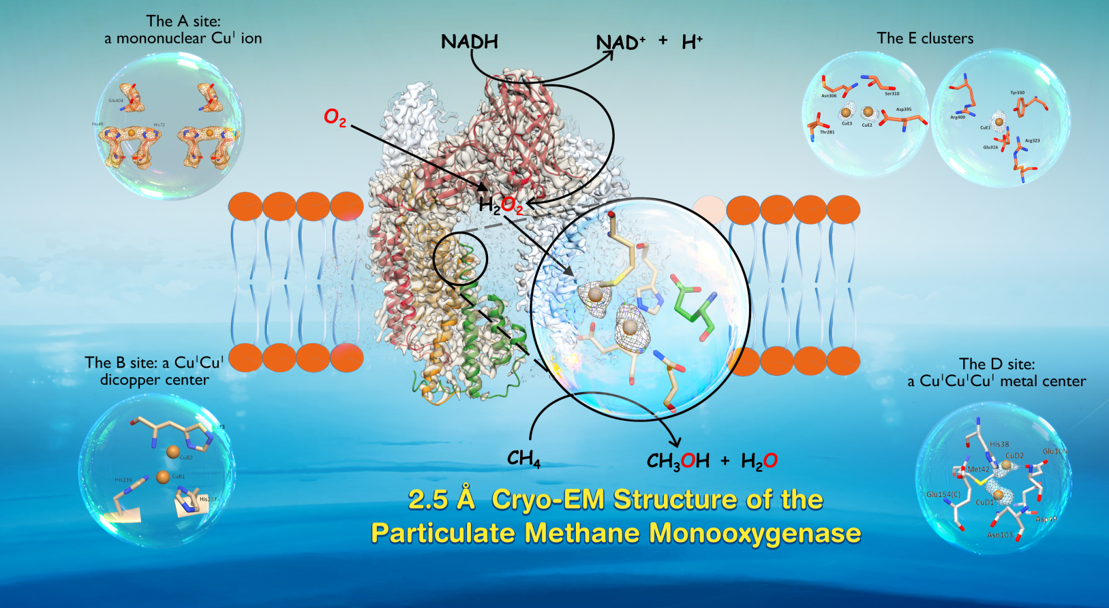Institute of Chemistry, Academia Sinica – Research
微粒體甲烷單加氧酶冷凍電顯結構中的銅簇中心揭示了將甲烷氧化的分子機器運轉的機制
Copper Centers in the Cryo-EM Structure of Particulate Methane Monooxygenase Reveal the Catalytic Machinery of Methane OxidationThe Journal of American Chemical Society 2021, 143, 9922-9932
Wei-Hau Chang*, Hsin-Hung Lin, I-Kuen Tsai, Shih-Hsin Huang, Szu-Chi Chung, I-Ping Tu, Steve S.-F. Yu* and Sunney I Chan*

The particulate methane monooxygenase (pMMO) is the first enzyme in the C1 metabolic pathway in methanotrophic bacteria. As this enzyme converts methane into methanol efficiently near room temperature, it has become the paradigm for developing an understanding of this difficult C1 chemistry. pMMO is a membrane bound protein with three subunits (PmoB, PmoA, and PmoC) and 12−14 coppers distributed among different sites. X-ray crystal structures that have revealed only three mononuclear coppers at three sites have neither disclosed the location of the active site nor the catalytic mechanism of the enzyme. Here we report a cyro-EM structure of holo pMMO from Methylococcus capsulatus (Bath) at 2.5 Å, and develop quantitative electrostatic-potential profiling to scrutinize the nonprotein densities for signatures of the copper cofactors. Our results confirm a mononuclear CuI at the A site, resolve two CuI s at the B site, and uncover additional CuI clusters at the PmoA/PmoC interface within the membrane (D site) and in the water-exposed C-terminal subdomain of the PmoB (E clusters). These findings complete the minimal set of copper factors required for catalytic turnover of pMMO, offering a glimpse of the catalytic machinery for methane oxidation according to the chemical principles underlying the mechanism proposed earlier.
顆粒狀甲烷單加氧酶 (pMMO) 是甲烷營養細菌 C1 代謝途徑中的第一個酶。由於這種酶在室溫附近有效地將甲烷轉化為甲醇,因此它已成為了解這種困難的 C1 化學的範例。之前X射線的晶體結構僅在三個位點顯示三個單核銅以致沒有揭示出活性位點的所在,這裡我們報告了來自 Methylococcus capsulatus (Bath)嗜甲烷菌,解析度達到 2.5 Å 的完整微粒體甲烷單加氧酶冷凍電顯結構,並且開發了定量靜電勢分析以成功辨識出非屬蛋白質的銅輔因子信號。我們發現A 位點的單核一價銅,在 B 位點雙核一價銅,並在 PmoA/PmoC 亞體界面發現額外的銅簇(D 位點)和 PmoB亞體暴露於水相的 C 端子域(E 簇)。這些發現完成了微粒體甲烷單加氧酶關於催化周轉所需的最小銅因子集合的拼圖,並使我們一窺了甲烷氧化催化的可能化學機制。
